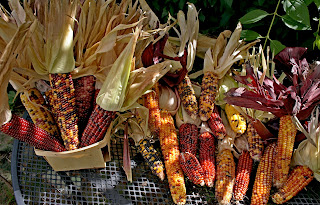Some of the ears of Calico popcorn that I recently harvested
I've gardened for many, many years, but this is the first year I've grown popcorn. Part of the reason I've not grown it before now is I just didn't have the room for it, OR sweet corn, but this year we created a new garden space which has opened up quite a bit of garden real estate for us. My dad grows popcorn once in a while, and I remember evenings at home, helping to shell some popcorn (usually Strawberry Popcorn) so we could pop it. He often had popcorn on the cob hanging decoratively on the fireplace in the living room, and whenever the mood for freshly-popped corn struck us, we'd grab an ear or two, shell it and pop it!
I had a spot in the garden where I'd planted some winter rye last fall, and that is where I decided to plant two varieties of popcorn: Calico, and Early Pink.
Calico, one of the two varieties of popcorn I planted this year
Calico popcorn seed
Earlier in the spring I cut the rye back but didn't till the area, so it looked something like a lawn. I wanted to experiment with planting directly into the un-tilled rye stubble figuring the cut rye would act something like a mulch. So, I grabbed my hoe and went to work digging the necessary trenches for the seed.
Planting directly into the rye stubble
Once planted, I only had to wait 3 months before picking time, and that happens to be right now!
Why hello there, Mr. Calico Popcorn!
It's fun to shuck the ears of popcorn and see what color is waiting beneath the layers of husks. The colors are intense and gorgeous! No human could create colors so extraordinary!
Calico Popcorn
The colors remind me of jellybeans! I can almost smell jellybeans....
Early Pink Popcorn. I think it crossed with the Calico...And these colors are stunning, too!
Another shot of the variety of colors of Calico popcorn
A lot of the popcorn that I picked could have dried a bit longer on the stalk, however, we've had so much rain lately that some of the corn was beginning to mold. I didn't want to take the chance that many more of the ears would succumb to mold, so I picked some before their time. The husks were mostly dry, but not completely so...hope that doesn't make much (if any) difference in corn quality.
An ear of Calico popcorn that is beginning to mold
The following excerpt on growing/storing popcorn was taken from the Horticulture and Home Pest News:
"Popcorn is grown for its tasty, exploding seed. Heating the kernel converts the moisture inside the kernel to steam and turns the seed inside out. The quality of the end product depends on the conditions during growing, harvest, and storage.
Growing
Several different varieties are available to home gardeners. Be sure to select a variety that will mature in your area. Sow seed directly in the garden in spring in several short rows. This ensures good pollination. Thin as recommended on label directions. Do not plant sweet corn in the same garden with popcorn. The quality of the sweet corn will be reduced if it is cross-pollinated by popcorn.
Water, fertilize, and weed regularly. Any serious stress like water deficiency can greatly reduce yields and the quality of the popcorn.
Harvest
Allow the kernels to dry in the field as long as possible. When harvested, the kernels should be hard and the husks completely dry.
After harvest, remove the husks and place the ears in mesh bags and hang in a warm, dry, well-ventilated location. The ideal moisture content for popcorn is between 13 and 14%. Once or twice a week, shell a few kernels and try popping them. When the test kernels are popping well and tasting good, shell and store the rest of the kernels. If the popcorn is "chewy" or the popped kernels are jagged, it is too wet and needs to continue drying.
Storage
Store the kernels in sealed, airtight containers. If stored properly, popcorn should retain its popping quality for several years. Unshelled corn should be stored at temperatures near 32F and high relative humidity. The storage location should also be rodent proof.
If stored popcorn fails to pop, it may be too dry. Add 1 tablespoon of water to a quart of popcorn. Cover and shake at frequent intervals until the popcorn has absorbed the water. After 3 or 4 days, test pop a few kernels to see if it is ready. Add more water and repeat the process until the popcorn pops well."










No comments:
Post a Comment